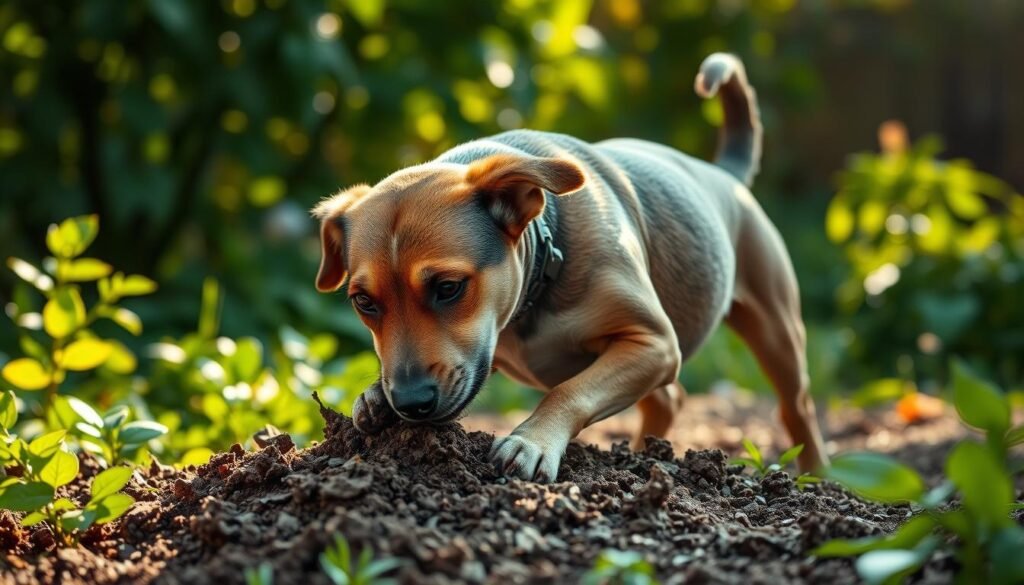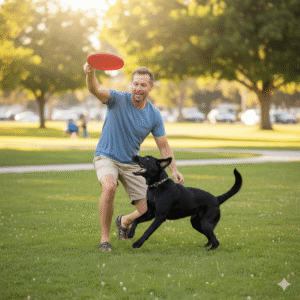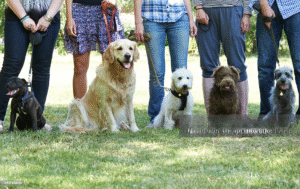Dog owners often face a common problem: digging. This habit can be frustrating and destructive. It leaves yards looking unkempt and can damage gardens or landscapes.
Addressing this behavior is crucial. It’s not just for a tidy outdoor space. It also ensures the dog’s safety and well-being. Dogs dig for many reasons, like boredom, anxiety, or instinct.
Understanding why your dog digs is the first step to solving the problem. In this article, we’ll look at effective ways to stop digging behavior.
Key Takeaways
- Understand why your dog is digging
- Provide adequate exercise and mental stimulation
- Implement training techniques to deter digging
- Supervise and redirect your dog’s behavior
- Consider environmental changes to prevent digging
Understanding Your Dog’s Digging Behavior
To stop a dog from digging, you need to know why they do it. Dogs dig for many reasons, like boredom, anxiety, or instinct.
Common Reasons Dogs Dig
Dogs dig for several reasons. Some dig to escape or hunt small animals. Others dig to cool off or find a cozy spot.
If your dog digs to escape, make sure their yard is fenced. For hunting instincts, give them toys filled with treats. The Toronto Humane Society’s guide explains why knowing the reason is important.
Recognizing Signs of Boredom
Boredom makes dogs dig. They need to stay active and mentally sharp. Signs of boredom include digging, destructive behavior, and too much barking.
Give your dog lots of toys and play with them often. Interactive toys and puzzle toys help keep their minds busy. Regular walks and playtime also help prevent digging.You can learn more about how to stop dog from eating poop.
Anxiety-Induced Digging
Anxiety also makes dogs dig. Separation anxiety is common. Dogs may dig when you leave or after you’ve gone.
To stop anxiety digging, create a calm space. Use calming aids or training. Sometimes, you might need professional help for anxiety issues.
Creating a Dog-Friendly Yard
A well-designed dog-friendly yard can help a lot. It can make your dog happier and reduce digging. By understanding your dog’s needs, you can create a space that meets those needs. This can help stop unwanted digging.
Safe Space for Your Dog to Play
It’s important to make a safe play area for your dog. Remove harmful materials and keep toxic substances out of reach. Make sure the yard is free from objects that could hurt your dog. A safe place to play and exercise can help reduce digging caused by boredom or too much energy.
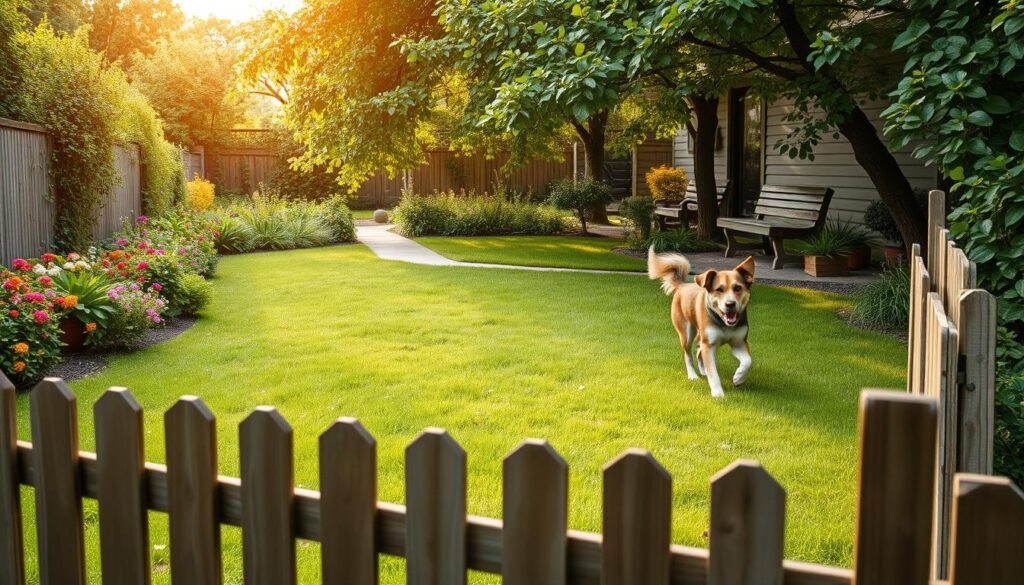
Providing Shelter and Shade
Dogs need a place to hide from the sun and rain. A shaded area or doghouse can be a cozy spot for them to rest. Experts say, “Dogs dig to find a cool spot to lie in. So, giving them shade is a simple fix.”
“Dogs often dig to create a cool spot to lie in, so providing alternative shade can be a simple solution.”
Enhancing the Digging Zone
If your dog likes to dig, make a special digging area. Bury toys or treats in it to make digging fun. This way, your dog will dig in the right place instead of other areas.You can learn more about how to stop dog barking.
- Designate a specific digging area
- Bury toys or treats to encourage digging
- Make the area appealing with sand or loose soil
By following these tips, you can make a yard that’s good for your dog. It will help reduce digging and make your dog happier.
Training Techniques to Discourage Digging
To stop your dog from digging, it’s important to know why they do it. Dogs dig for reasons like boredom, anxiety, or instinct. By finding the cause and using the right training, you can stop this behavior.
Positive Reinforcement Strategies
Positive reinforcement is a great way to train dogs. It rewards them for good behavior, like not digging. Reward-based training means praising or giving treats for good actions.
For example, if your dog starts digging, distract them with a toy. Then, reward them for not digging. It’s crucial to be consistent with commands and rewards to avoid confusion.
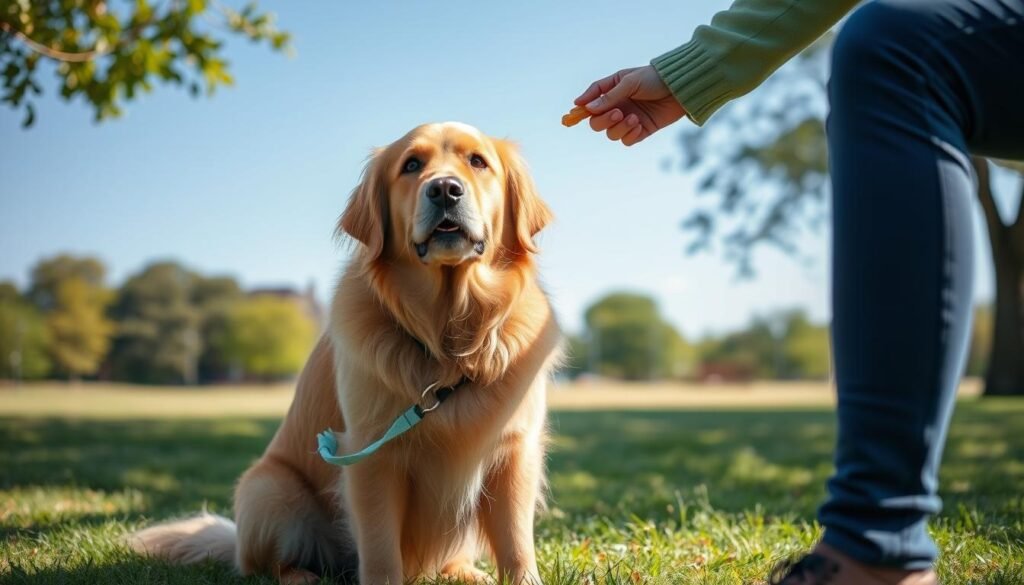
Teaching “Leave It” Command
The “leave it” command is useful for stopping bad behaviors, like digging. Start by placing a treat in front of your dog and telling them to leave it. When they ignore the treat, give them another treat or praise.
Make it harder by using different objects and places. This command teaches your dog to control themselves and can stop digging in unwanted spots.
Redirecting the Behavior
Redirecting your dog’s digging to a good spot is another good strategy. Pick a place in your yard where digging is okay. Bury toys or treats there to encourage digging. Reward them with praise or treats when they dig there.
For more tips on stopping digging, check out the AKC’s expert advice page on dogs that like to dig.
| Training Technique | Description | Effectiveness |
|---|---|---|
| Positive Reinforcement | Rewarding desired behaviors | High |
| “Leave It” Command | Teaching self-control | Medium-High |
| Redirecting Behavior | Designating a digging area | High |
Exercise: The Key to Reducing Digging
To stop dog digging behavior, regular physical activity is key. Dogs dig due to too much energy or boredom. Exercise helps solve these problems.
Daily Walks and Playtime
Daily walks and play are vital for burning off energy. A well-exercised dog is less likely to dig. Aim for at least 30 minutes of activity daily, based on your dog’s needs.
Interactive Toys for Engagement
Interactive toys keep your dog’s mind busy and reduce digging. Toys that dispense treats or solve problems work well. For more ideas, check out Petful.
“A tired dog is a happy dog,” as the saying goes, and it’s true for reducing digging.
Dog Parks and Activities
Dog parks and activities give your dog physical and social stimulation. Regular visits to dog parks help burn energy and satisfy the urge to play, reducing digging.
By adding these exercise strategies to your routine, you can cut down on your dog’s digging. A well-exercised dog is happier and healthier.
Using Deterrents Effectively
Using deterrents is a smart way to stop dogs from digging. These can be physical barriers or things that make digging unappealing to your dog.
Safe Barriers and Fencing
Creating a physical barrier is a top way to stop digging. Fencing works well, even for determined diggers. Make sure the fence is deep to stop burrowing.
Use materials like hardware cloth or chain link. They’re hard for dogs to dig through or climb.
Here’s a comparison of different fencing materials:
| Material | Durability | Cost |
|---|---|---|
| Hardware Cloth | High | Moderate |
| Chain Link | High | Moderate to High |
| Wooden Fencing | Moderate | Low to Moderate |
Natural Deterrent Solutions
For a natural approach, try spray deterrents made from citrus or vinegar. Dogs often dislike these smells and tastes, so they won’t dig as much.
Other natural deterrents include:
- Planting daffodils or hot peppers around the perimeter, as dogs tend to avoid these plants.
- Using motion-activated sprinklers to startle dogs when they attempt to dig.

Commercial Dog Repellents
If natural deterrents don’t work, consider commercial dog repellents. These products are made to keep dogs from digging. They come in sprays, granules, and electronic devices.
When picking a commercial repellent, think about:
- Safety: Make sure it’s safe for your dog and other pets.
- Effectiveness: Check reviews and testimonials to see how well it works.
- Ease of use: Pick something easy to apply or install.
Using deterrents well can really cut down on your dog’s digging. It’s key to use these methods with training and exercise for the best results.
Addressing Separation Anxiety
Digging can be a sign of deeper issues, like separation anxiety, in dogs. Dogs left alone may feel distressed, leading to destructive digging. It’s key to understand and tackle this issue to stop the digging.
Recognizing Symptoms of Anxiety
Spotting signs of separation anxiety is the first step. Common signs include:
- Digging or other destructive behaviors when left alone
- Pacing or restlessness
- Excessive barking or howling
- Escaping or attempting to escape
If you see these signs, it’s vital to act to ease your dog’s anxiety.
Tips for Creating a Calm Environment
Creating a calm space can help with separation anxiety. Here are some tips:
- Leave an article of clothing, like a t-shirt, with your scent on it for your dog to comfort with.
- Provide a familiar toy or object that your dog associates with comfort.
- Gradually increase the time you spend away from your dog to help them adjust.
- Use calming aids like pheromone diffusers or calming music.
These strategies can help make your dog’s environment more relaxed.
Professional Help for Extreme Cases
In severe cases, professional help is needed. A professional dog trainer or behaviorist can offer tailored advice. They can help you create a training plan to reduce digging and anxiety.
Engaging with Your Dog’s Instincts
To stop a dog from digging up the yard, it’s key to understand their instincts. Dogs dig for reasons like boredom, anxiety, and instinct. By acknowledging these instincts, you can guide their digging into better habits.
Providing Natural Behaviors Outlet
Dogs dig because it’s in their nature, a trait from their wild ancestors. Giving them a place to dig can reduce yard digging. You can set up a sandbox or a special area in your yard for them to dig.
By letting your dog dig in a controlled space, you meet their natural urge. For more tips on managing digging, check out Humaneworld.org.
Understanding the Importance of Mental Stimulation
Mental stimulation is vital for dogs. It keeps their minds active and prevents destructive digging. Interactive toys, puzzle feeders, and playtime can keep their minds sharp.
Games like hide-and-seek or scent work are great. They challenge your dog’s mind and strengthen your bond.
Activities that Satisfy Digging Instincts
There are more ways to satisfy your dog’s digging urge. Hiding treats or toys in the ground can encourage digging. It’s a fun way to keep their mind active.
Outdoor activities like playing with a shovel or agility training also work. They channel their energy into positive, less destructive ways.
When to Seek Professional Help
If your dog keeps digging, it might be time to get help from a pro. Some digging issues are too hard to solve on your own.
Identifying Severe Digging Problems
Big digging problems can harm your yard or show other bad behaviors. Severe digging problems need a pro’s help.
Look out for these signs of serious digging issues:
- Digging that ruins your yard
- Digging with other bad habits
- Digging that won’t stop, even when you try
Finding a Qualified Dog Trainer
Finding the right qualified dog trainer or behaviorist is key. Look for someone with experience in fixing digging and other bad behaviors.
| Qualities to Look for in a Dog Trainer | Description |
|---|---|
| Experience with digging issues | Make sure the trainer knows how to handle digging problems |
| Positive reinforcement techniques | Choose trainers who use kind and positive methods |
| Certifications and credentials | Check for real certifications from known groups |
A good trainer can find out why your dog digs and make a plan to stop it, says a pro.
“A good trainer can find out why your dog digs and make a plan to stop it.”
– Professional Dog Trainer
Behavioral Assessment Options
A pro will start with a behavioral assessment to figure out why your dog digs.
This might include:
- Watching how your dog acts
- Talking about your dog’s past and habits
- Finding out what makes them dig
Getting help from a pro can help you understand your dog better. You can then find ways to stop their digging.
Maintaining Ongoing Solutions
To stop a dog from digging, you need to keep working on it. Regularly spending time with your dog and watching their behavior is key. This helps keep the strategies you use working well over time.
Regular Checks
Check your yard and your dog’s actions often. This helps you spot when they might start digging. You can then quickly change things to stop it.
Adapting to Change
As your dog gets older, they might need different things. You need to change your plans to meet these new needs. For example, they might dig less but need more exercise.
Fostering Healthy Habits
Helping your dog develop good habits is important. Give them things to do and places to run. This keeps them busy and away from digging. For more tips, check out Chewy’s education page on stopping dogs from digging.


